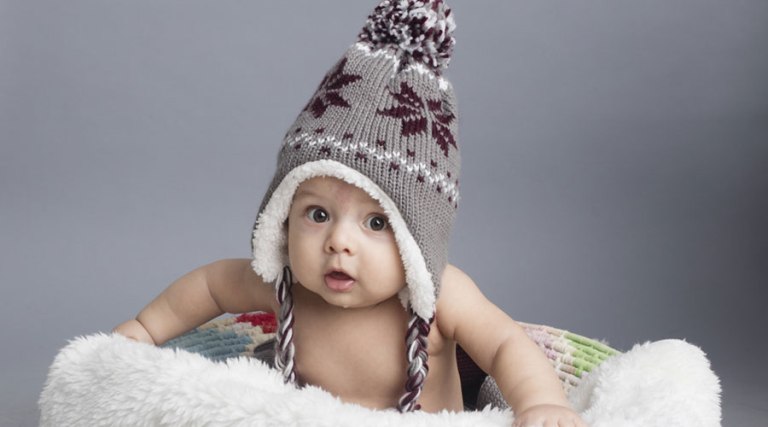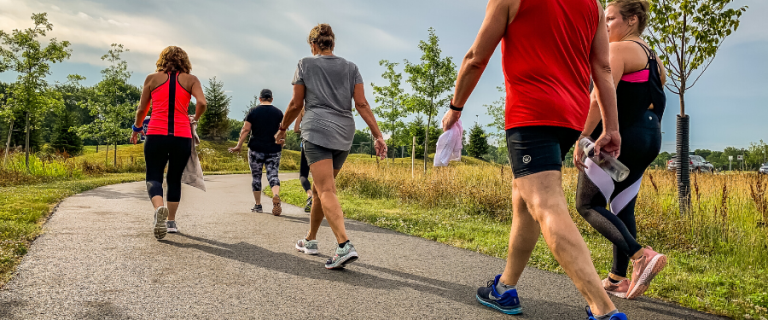
Infants lose heat faster than adults, and the younger their age, the less able they are to cope with cold. COURTESY
For new moms, you'll probably get a bit stir crazy with your little one, especially during the cold weather months. But it's important to safely step outside when you can. "Babies and new parents need fresh air," says New York pediatrician Erika Landau, M.D., coauthor of The Essential Guide to Baby's First Year. "Unless it's dangerously cold, being outdoors helps infants acclimate to the seasons and the day-and-night cycle, and it often calms fussiness."
Even so, new parents must follow safety precautions. Once the temperature gets below freezing, you shouldn't take your baby out, except for quick trips back and forth to the car. Even when it's above freezing, wind chill can make it dangerous. "Newborns and infants do not yet have the ability to self regulate their core temperature," says Janice Montague, M.D., of Tuxedo Pediatrics in Suffern, NY. She recommends limiting the exposure to the cold elements to a few minutes at a time, and saving play in the snow for when kids are older.
"Infants lose heat faster than adults, and the younger their age, the less able they are to cope with cold," adds Kate Puttgen, M.D., a pediatric dermatologist practicing at Intermountain Healthcare in Taylorsville, Utah. "Small babies lack the ability to increase heat by shivering and don't have the body fat needed to warm back up once they get cold."
Here are expert ways to keep your baby warm and safe this winter.
Dress your baby in layers
"If you are comfortable with a jacket on top of your clothes, you should have your baby in a jacket or snowsuit and a blanket," says Molly Broder, M.D., a pediatrician at the Children's Hospital at Montefiore Medical Center in the Bronx, New York. Dressing your infant in layers allows you to adjust to her needs. "The bottom layer can be snug, like leggings and a bodysuit. On top of that, you can put another layer of pants and a long sleeve shirt. Finish up with a jacket, hat, mittens, and warm booties to keep hands and feet warm," says Dr. Broder. Choose breathable fabrics such as cotton and muslin so you can take clothes on and off as needed.
Ditch the coat in the car
Taking off your baby's coat in the car may seem counterintuitive. But the problem with that cute puffy coat is if there's too much material between the baby and the car seat straps, the material could compress during an accident, leaving space for your baby to become unsecured. "Coats are unsafe because you need to loosen the car seat harness in order to accommodate them, but in a crash they can compress, leaving a big gap between the harness and child, upping her chance of injury," explains Rallie McAllister, M.D., of Lexington, Kentucky, coauthor of The Mommy M.D. Guide to Your Baby's First Year.
Instead, click your baby into the car seat first, and then layer. "If you're using a car seat cover, you should buy one that doesn't come between the baby and the car seat—it should be over the lower part of the baby, like a blanket," says Dr. Broder. "Alternatively, you can use a blanket or coat (placed on top), and then remove it once the car warms up so the baby doesn't get overheated." You can also pre-warm the car to keep your baby cozy.
Bundle up for a jaunt outside
If the temperature or windchill dips below freezing, or if nonfreezing temperatures are mixed with wind or rain, keep your little one inside except for brief excursions, like to and from the car. If it's not arctic outdoors, dress him in a winter jacket, a hat that covers his ears, mittens, and a stroller blanket or bunting. "Check your baby often for signs of discomfort. If his face gets red, his skin is warm, and he's fussy, he's probably overheated. If he's fussy and teary-eyed, and his skin is cold to the touch, he's probably not bundled up enough," says Dr. McAllister.
Wear your baby for warmth
Carriers are a great way to use your body heat to provide extra coziness for baby in the cold weather—but then he probably doesn't need that extra sweater. Even so, "always keep their head and feet covered as that is how they lose heat," says Dr. Montague. As always when you're wearing your baby, make sure his face is not pressed against your chest or clothing (especially when you're donning a winter jacket) to keep his airway free. "And be careful of ice and slipping and falling yourself," adds Dr. Montague.
Be careful when covering your baby's stroller
In an abundance of caution you might want to throw a blanket over your baby's stroller, or protect it with those old-fashioned plastic covers. But Dr. Montague warns that this could compromise the air flow to your baby inside. "Many strollers have covers especially fitted to that brand to allow appropriate air circulation," suggests Dr. Broder. "Otherwise, put your baby in a jacket, hat, mittens, and booties, and then tuck her under a blanket to chest level to keep her warm and snuggly in the stroller." If you can, try to walk against the wind.
Keep the indoor temperature right
You may be worried about the baby being too cold, but too much indoor heat can also be a problem. "Indoor heating has low humidity, and it's that lack of moisture in the air that can dry your baby's delicate skin," says Dr. Puttgen. "To avoid that, keep your indoor temperature as cool as you can tolerate during the day—anywhere between 68°F and 72°F." When your little one is sleeping, however, you should set the thermostat lower, to between 65°F and 68°F, which will not only benefit her skin, but can reduce her risk of SIDS, research shows. Dress your baby in a sleeper and sleep sack—a wearable blanket—to keep her warm enough.
Prevent dry skin
"Cold temperatures, the lack of humidity, and recirculated air can all contribute to dry, itchy, scaly skin," says Dr. Swanson. Ironically, water can dry out skin, and most babies don't really need to be washed daily in the winter anyway. Use warm water (not hot) and don't let your baby soak too long. Keep the water to about 100°F (stick your elbow in to gauge; it should feel comfortably warm, not hot) and limit time in the tub to 10 minutes, less for a newborn. "When you dry baby off, apply a good moisturizer without a laundry list of chemicals," says Dr. Montague. "Reapply moisturizer as many times daily as you like." Dr. Broder says the goopier the better, so consider using ointments, which lock in moisture better than creams. If your baby's skin turns red or irritated, call the pediatrician.
Watch out for warning signs
If your baby starts shivering, or his extremities—hands, feet and face—are cold and red, or have turned pale and hard, bring him inside right away. "You shouldn't rub the cold area to rewarm it, as this could further damage the cold skin," says Dr. Broder. Instead, use warm washcloths to gently reheat the skin, then put on warm and dry clothes. If he doesn't improve in a few minutes, call your doctor. Other signs that your infant has gotten too cold and needs medical attention are lethargy, non-responsiveness, and blue lips or face.












0 Comments